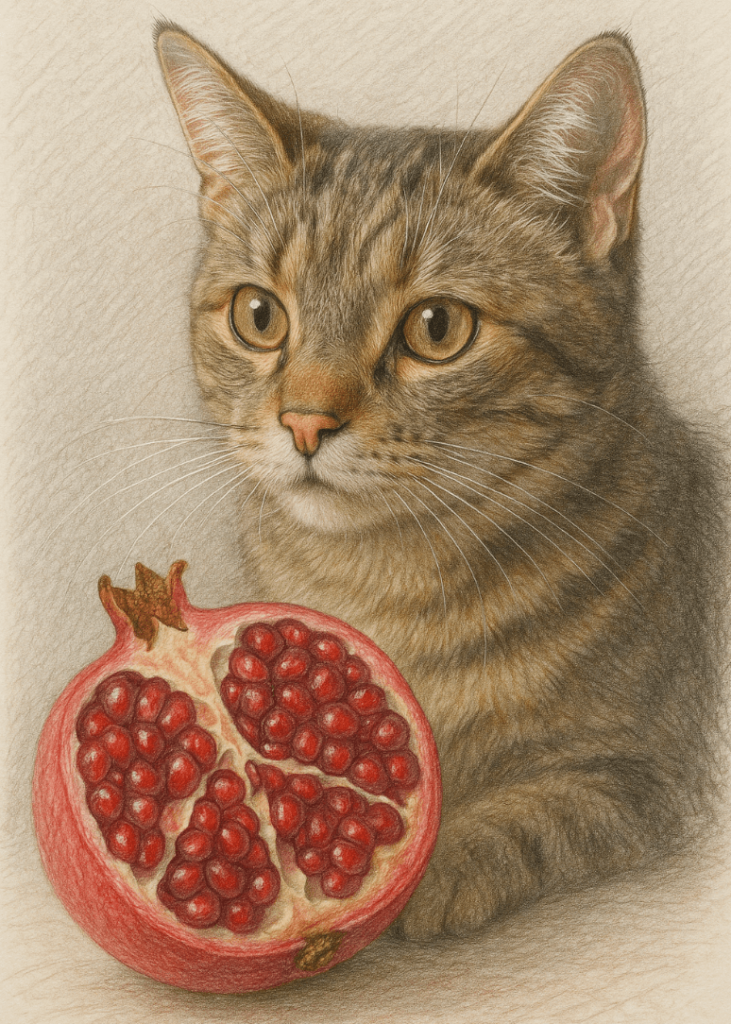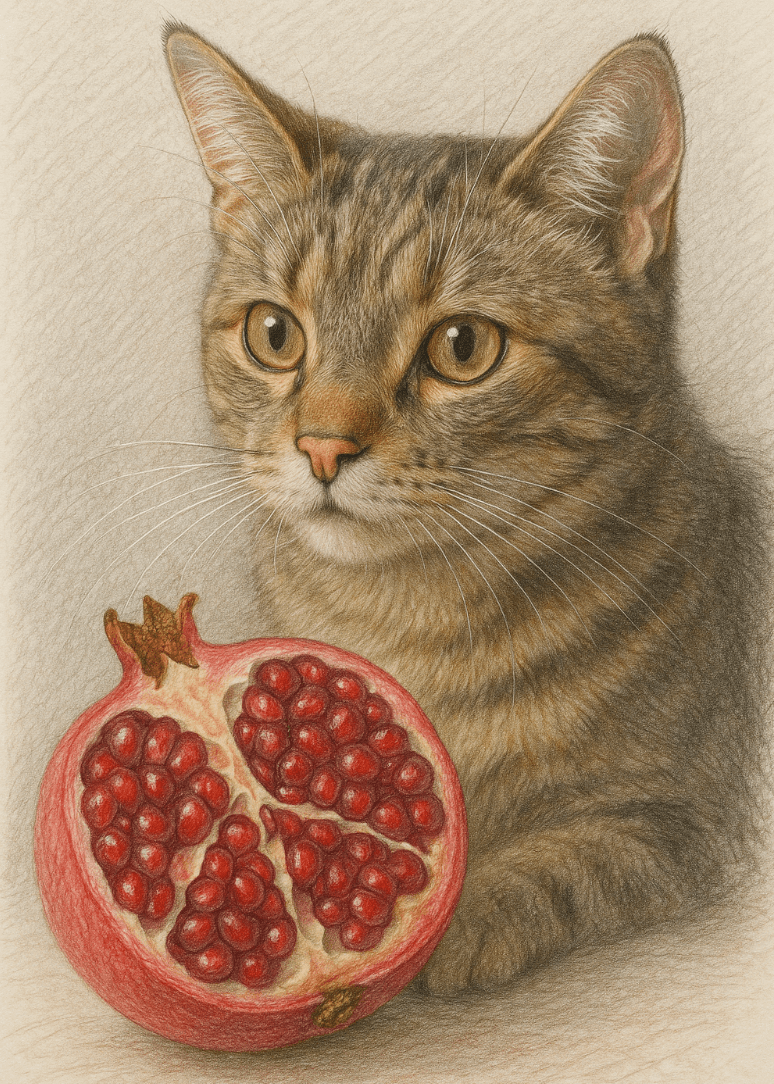Can Cats Eat Pomegranate?
Pomegranates are a delicious and nutrient-rich fruit enjoyed by humans for their sweet-tart flavor and health benefits. But when it comes to our feline companions, can cats safely enjoy this vibrant fruit too? While cats are obligate carnivores and don’t require fruits in their diet, many pet owners wonder if occasional treats like pomegranate are safe or even beneficial. In this blog post, we’ll explore whether cats can eat pomegranate, potential risks and benefits, and how to introduce new foods to your cat responsibly. By the end, you’ll have all the information you need to make informed decisions about sharing this fruit with your furry friend.
Potential Risks of Feeding Pomegranate to Cats
While pomegranate is generally safe for humans, it may pose certain risks to cats if not introduced carefully. Understanding these potential dangers will help you decide whether to offer this fruit to your pet.
Digestive Upset:
Cats’ digestive systems are not designed to process large amounts of fruit. Eating pomegranate seeds or juice may cause vomiting or diarrhea.Choking Hazard:
The small, hard seeds of pomegranate could pose a choking risk, especially for curious cats who might swallow them whole.High Sugar Content:
Pomegranate contains natural sugars that can be unhealthy for cats, particularly those with diabetes or obesity issues.Toxicity Concerns (Rare):
While pomegranate itself isn’t toxic, some cats may have allergic reactions or sensitivities to unfamiliar foods.Overeating Risk:
Cats lack the ability to self-regulate portion sizes with human foods, leading to overconsumption and potential health problems.
These risks highlight why moderation and supervision are key when introducing any new food to your cat’s diet.
Potential Benefits of Pomegranate for Cats (In Moderation)
Although cats don’t need fruits in their diet, pomegranate does offer some minor benefits when given sparingly. These advantages are limited but worth noting.
Antioxidant Properties:
Pomegranate is rich in antioxidants, which may support overall health by reducing oxidative stress in small amounts.Hydration Boost:
The juicy arils of pomegranate can provide a mild hydration boost, especially during warmer months.Mental Stimulation:
Offering a tiny piece of pomegranate as an occasional treat can satisfy your cat’s curiosity and provide enrichment.Low-Calorie Snack Option:
Compared to processed cat treats, a small amount of pomegranate is a low-calorie alternative for healthy cats.Encouraging Exploration:
Introducing novel textures and flavors can stimulate your cat’s senses and encourage playful behavior.
While these benefits exist, they should be weighed against the potential risks before offering pomegranate to your cat.
Check this guide 👉Can Cats Eat Soy Sauce? Best 7 Expert Tips!
Check this guide 👉Can Cats Eat Squid? Best 7 Expert Tips!
Check this guide 👉Can Cats Eat Lime? Best 7 Expert Tips!

Safe Ways to Offer Pomegranate | Risks to Avoid When Feeding Pomegranate |
|---|---|
Remove seeds before offering | Never feed large quantities at once |
Serve only the soft aril part | Avoid giving pomegranate juice |
Limit portions to one or two arils | Don’t mix with other unfamiliar foods |
Monitor for adverse reactions | Skip feeding if your cat has dietary issues |
Use as an occasional treat, not daily | Keep whole fruit out of reach |
How to Safely Introduce Pomegranate to Your Cat
If you decide to let your cat try pomegranate, it’s important to do so cautiously to avoid any negative effects. Follow these guidelines to ensure a safe experience.
Start with Tiny Portions:
Offer just one or two small pieces of the soft aril to see how your cat reacts.Observe for Allergic Reactions:
Watch for signs of itching, swelling, or gastrointestinal distress after consumption.Remove Seeds and Rind:
Ensure no seeds or tough rind pieces are included, as these can cause choking or indigestion.Avoid Processed Forms:
Stick to fresh pomegranate and avoid products like juices or syrups, which often contain added sugars or preservatives.Consult Your Veterinarian:
Always check with your vet before introducing new foods, especially if your cat has pre-existing health conditions.
Taking these precautions ensures your cat enjoys pomegranate safely without compromising their well-being.
Signs Your Cat May Not Tolerate Pomegranate
Even if pomegranate is technically safe, some cats may struggle to digest it properly. Recognizing these warning signs allows you to act quickly if something goes wrong.
Vomiting or Diarrhea:
These symptoms indicate that your cat’s stomach is struggling to process the fruit.Loss of Appetite:
If your cat refuses to eat after trying pomegranate, it could signal discomfort or nausea.Excessive Drooling:
Drooling may occur if your cat finds the texture unpleasant or if irritation develops in their mouth.Lethargy or Weakness:
A sudden lack of energy suggests that your cat may be experiencing an adverse reaction.Behavioral Changes:
Signs of agitation, pacing, or hiding might indicate discomfort or illness.
If you notice any of these signs, stop offering pomegranate immediately and consult your veterinarian.
Common Mistakes to Avoid When Feeding Pomegranate
Feeding pomegranate to your cat requires careful consideration to avoid mistakes that could harm their health. Here are some pitfalls to watch out for.
Offering Large Quantities:
Feeding too much pomegranate can overwhelm your cat’s digestive system and lead to stomach upset.Including Seeds or Rind:
Seeds and rind are difficult to digest and can pose choking hazards or cause blockages.Mixing with Other Foods:
Combining pomegranate with other unfamiliar foods increases the risk of adverse reactions.Ignoring Pre-Existing Conditions:
Cats with diabetes, obesity, or kidney issues should avoid sugary fruits like pomegranate entirely.Assuming All Cats Will Like It:
Some cats simply won’t be interested in pomegranate, and forcing them to try it can create negative associations.
Avoiding these mistakes ensures a safer and healthier experience for your cat.
Alternatives to Pomegranate for Cats
If pomegranate doesn’t suit your cat’s palate or dietary needs, there are plenty of safer fruit options that can serve as occasional treats.
Blueberries:
Rich in antioxidants and low in calories, blueberries are a safe and nutritious option for cats.Seedless Watermelon:
This hydrating fruit provides a refreshing snack, but always remove seeds and rind first.Apples (Core Removed):
Apples are a good source of fiber and vitamin C, but avoid the core and seeds due to cyanide content.Bananas (In Small Amounts):
Bananas are high in potassium but also sugar, so limit portions to prevent weight gain.Strawberries:
Strawberries are packed with vitamins and antioxidants, making them a tasty treat in moderation.
These alternatives allow you to diversify your cat’s diet while minimizing risks.
Understanding Your Cat’s Dietary Preferences
Cats are naturally selective eaters, and their preferences play a significant role in determining what foods they’ll accept. Here’s how to better understand your cat’s tastes and habits.
Obligate Carnivore Instincts:
Cats prioritize protein-rich foods, so fruits like pomegranate may not appeal to their instincts.Texture Sensitivity:
Many cats dislike sticky or mushy textures, which could explain aversion to certain fruits.Curiosity vs. Caution:
Some cats may show interest in new foods purely out of curiosity, not hunger.Individual Tolerance Levels:
Every cat is different—what one cat tolerates well, another may reject entirely.Consistency Over Variety:
Most cats prefer consistency in their diet, relying on familiar foods rather than experimenting with new ones.
By recognizing these traits, you can tailor your approach to feeding and ensure your cat remains comfortable and satisfied.
Frequently Asked Questions About Cats and Pomegranate
Is pomegranate toxic to cats?
No, pomegranate is not toxic, but it can cause digestive upset if consumed in large amounts.
Can kittens eat pomegranate?
Kittens have sensitive digestive systems, so it’s best to avoid giving them pomegranate altogether.
How much pomegranate can I give my cat?
Limit portions to one or two small arils as an occasional treat—never more than that.
What should I do if my cat eats a lot of pomegranate?
Contact your veterinarian immediately to assess the situation and prevent complications.
Are there safer fruit options for cats?
Yes, fruits like blueberries, watermelon (seedless), and apples (core removed) are safer alternatives.
Prioritizing Your Cat’s Health When Offering Pomegranate
While pomegranate can be an occasional treat for cats, it’s essential to approach its introduction with caution. Cats are obligate carnivores, meaning their nutritional needs are best met through meat-based diets rather than fruits. By understanding the potential risks and benefits, monitoring your cat’s reactions, and consulting your veterinarian, you can ensure your pet stays happy and healthy. Remember, moderation is key—pomegranate should never replace a balanced diet tailored to your cat’s unique needs. With care and attention, you can provide your feline friend with a varied and enriching diet while keeping their well-being a top priority.
Understanding Valley Fever in Cats: Best 7 Expert Tips! Valley fever—also known as coccidioidomycosis—is a fungal infection that can affect cats, especially …
How to Adopt a Retired Military Dog: Best 7 Expert Tips! – Learn eligibility, preparation, and care for a heroic veteran dog.
Understanding Lungworm in Cats: Best 7 Expert Tips! – Spot symptoms, treat safely, and protect your cat from this hidden parasite.
Understanding Carcinoma in Cats: Best 7 Expert Tips! – Spot early signs, explore treatment options, and support your cat with expert-backed care.




